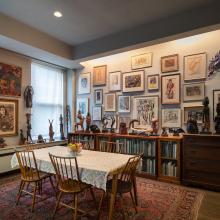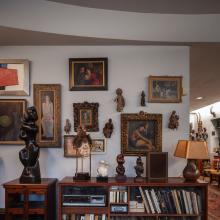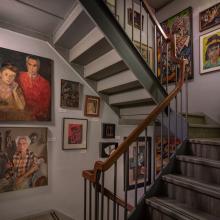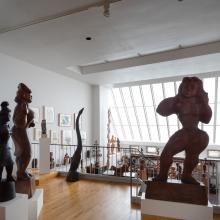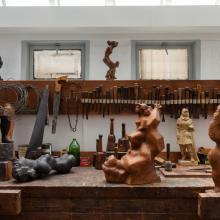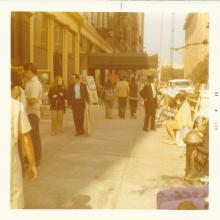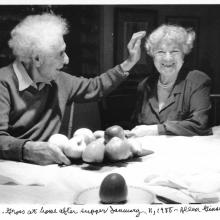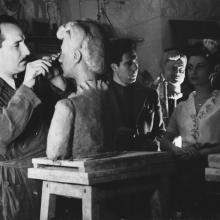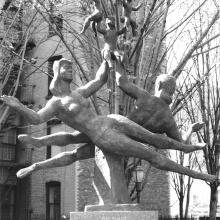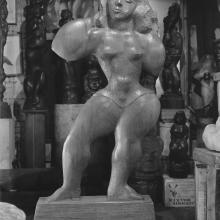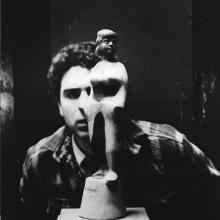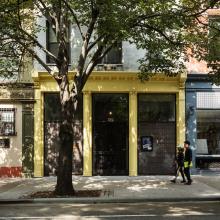
The Renee & Chaim Gross Foundation
Chaim Gross, b 1902- d 1991526 LaGuardia Place, New York, NY 10012 - view on Google Maps
212-529-4906
212-529-4906
“Art gives me happiness, and when I’m not working I’m miserable ”
—Chaim Gross
The Renee & Chaim Gross Foundation preserves and interprets the historic home, studio, and art collections of renowned American sculptor Chaim Gross and his wife Renee. The Grosses purchased the Foundation’s Greenwich Village building in 1962, renovating the industrial space into a modernist home and ground floor sculpture studio. In addition to being a prolific artist, Gross was also a collector, educator, and designer. Gross worked with two architects, Arthur Malsin and Don Reiman, on the 1962-63 Modernist renovations of the LaGuardia Place building. Included in the design decisions made by Gross are the end-grain floor in the studio and oak handrails in the stairwell. He collected widely and the Foundation preserves and interprets his collections. Gross collected African, American, European, Oceanic, Pre-Columbian, and decorative arts. He also amassed an extensive art history library.
ABOUT
The Foundation provides a window into the life of a twentieth-century artist living in New York. The space is profoundly linked with Gross’s network of friendships and influences as seen in the Foundation’s extensive art collections, installed as they looked during Gross’s lifetime on the Foundation’s third floor and n the stairwell gallery. The studio, lit dramatically by a Modernist skylight, was the site for his creative output and features works in progress, materials, and tools used by the artist.
The Renee & Chaim Gross Foundation’s mission is to further the legacy of Chaim Gross through high-quality research, exhibitions, and educational activities around the Foundation’s historic building and art collections for audiences in New York City and beyond.
Gross was born in 1902 in the province of Galicia, at the time a part of Austria-Hungary but now in Ukraine, and emigrated from war-torn Europe in 1921. He studied drawing and painting in Budapest, Hungary with Béla Uitz, but was uprooted by anti-Semitism.
Soon after arriving in the United States, Gross enrolled at the Educational Alliance Art School on the Lower East Side. There he developed many close friendships with key 20th-century New York artists like Moses and Raphael Soyer, Peter Blume, and Adolph Gottlieb. Gross continued his study of sculpture with Robert Laurent at the Art Students League and Elie Nadelman at the Beaux-Arts Institute of Design. He established his own studio in 1927, leading to his first solo show of direct carvings in 1932 at Gallery 144. Not long after, his sculptures were acquired by major American museums including The Metropolitan Museum of Art and the Whitney Museum of American Art. Today, the largest body of Gross’s work in a public collection is at the Hirshhorn Museum in Washington, D.C.
Gross is renowned for his direct wood carvings of circus performers, dancers, and intimate mother and child pairings. He created these subjects in a style that combined Modernist, African, and folk forms. In the 1950s, Gross turned his attention to bronze sculpture, which he used on both an intimate and a large scale. His outdoor sculpture The Family (1979), gifted to the City of New York in 1991, continues to be an attraction in Bleecker Street Playground at the corner of West 11th Street.
Renee and Chaim Gross purchased 526 LaGuardia Place in 1962 after living and raising their two children (artist Mimi Gross and engineer Yehudah Gross) on the Upper West Side. Prior to their decision to unite living and work spaces, Gross had various studios in the Village since 1927.
The four-story brick building on LaGuardia Place was originally built in 1873 and designed by Joseph M. Dunn as a storefront with lofts above. When the Grosses purchased it, the building was industrial use as an art shipping and storage company. They retained the original Neo-Grec cast-iron features on the façade, but chose to renovate the interiors in a Modernist style. Architects Arthur Malsin and Don Reiman worked on the project, but Gross was heavily involved in decision making during the process of design and construction.
Gross worked in the dramatically lit sculpture studio on the ground floor from 1963 until his death in 1991. The adjacent gallery continues to display finished works by Gross as it did when he actively used the space. Included are drawings as well as sculptures in wood, stone, and bronze. The second floor was rented out prior to 1991 and now serves as an intimate temporary exhibition space for exploring aspects of Gross’s work and collection. The stairwell and third floor are installed with the couple’s extensive collection which includes 12,000 objects of African, American, European, Pre-Columbian, and decorative arts. Gross installed these works in a Salon-style hang that has been deliberately retained by the Foundation to evoke Gross’s aesthetics as well as his network of artists and friends.
Gross was born in 1902 in the province of Galicia, at the time a part of Austria-Hungary but now in Ukraine, and emigrated from war-torn Europe in 1921. He studied drawing and painting in Budapest, Hungary with Béla Uitz, but was uprooted by anti-Semitism.
Soon after arriving in the United States, Gross enrolled at the Educational Alliance Art School on the Lower East Side. There he developed many close friendships with key 20th-century New York artists like Moses and Raphael Soyer, Peter Blume, and Adolph Gottlieb. Gross continued his study of sculpture with Robert Laurent at the Art Students League and Elie Nadelman at the Beaux-Arts Institute of Design. He established his own studio in 1927, leading to his first solo show of direct carvings in 1932 at Gallery 144. Not long after, his sculptures were acquired by major American museums including The Metropolitan Museum of Art and the Whitney Museum of American Art. Today, the largest body of Gross’s work in a public collection is at the Hirshhorn Museum in Washington, D.C.
Gross is renowned for his direct wood carvings of circus performers, dancers, and intimate mother and child pairings. He created these subjects in a style that combined Modernist, African, and folk forms. In the 1950s, Gross turned his attention to bronze sculpture, which he used on both an intimate and a large scale. His outdoor sculpture The Family (1979), gifted to the City of New York in 1991, continues to be an attraction in Bleecker Street Playground at the corner of West 11th Street.
Renee and Chaim Gross purchased 526 LaGuardia Place in 1962 after living and raising their two children (artist Mimi Gross and engineer Yehudah Gross) on the Upper West Side. Prior to their decision to unite living and work spaces, Gross had various studios in the Village since 1927.
The four-story brick building on LaGuardia Place was originally built in 1873 and designed by Joseph M. Dunn as a storefront with lofts above. When the Grosses purchased it, the building was industrial use as an art shipping and storage company. They retained the original Neo-Grec cast-iron features on the façade, but chose to renovate the interiors in a Modernist style. Architects Arthur Malsin and Don Reiman worked on the project, but Gross was heavily involved in decision making during the process of design and construction.
Gross worked in the dramatically lit sculpture studio on the ground floor from 1963 until his death in 1991. The adjacent gallery continues to display finished works by Gross as it did when he actively used the space. Included are drawings as well as sculptures in wood, stone, and bronze. The second floor was rented out prior to 1991 and now serves as an intimate temporary exhibition space for exploring aspects of Gross’s work and collection. The stairwell and third floor are installed with the couple’s extensive collection which includes 12,000 objects of African, American, European, Pre-Columbian, and decorative arts. Gross installed these works in a Salon-style hang that has been deliberately retained by the Foundation to evoke Gross’s aesthetics as well as his network of artists and friends.
Did you know...?
The building at 526 LaGuardia Place was an art storage and moving company called Berkeley Express when the Grosses purchased it.SPECIAL RESOURCES
Archive and libraryExtensive collection of works by Chaim Gross.
The artist's collections of historic African, American, European, Oceanic, Pre-Columbian, and decorative arts installed as they looked during the artist’s lifetime.
Event rental
view on Google Maps
NEARBY SITES
- Judd Foundation0.36 mi.
- Alice Austen House8.53 mi.
- Edward Hopper House Museum & Study Center25.56 mi.
- Bush-Holley House29.75 mi.
- Arthur Dove/Helen Torr Cottage34.56 mi.
- Manitoga/The Russel Wright Design Center42.85 mi.
- Weir Farm National Historical Park46.24 mi.
WHAT TO DO HERE
- Take a tour of the house and studio
- Participate in one of the site's education programs (please see site website for details)
YOU CAN ALSO SEE THE ART HERE:
- The Metropolitan Museum of Art, New York City, NY
- Smithsonian American Art Museum, Washington, DC
- Bleecker St. Park (at W 11th St), New York City, NY
- Fordham University, W 60th St and Columbus Ave, New York City, NY
- Pace University, Financial District, New York City, NY
- City College of New York, Amsterdam Ave and 134th St, New York City, NY
- Brooklyn Museum, Brooklyn, NY
- Farleigh Dickinson University, Madison, NJ
- The New School, New York City, NY
- The McNay Art Museum, San Antonio, TX
- Nassau County Museum of Art, Roslyn, NY
- New Britain Museum of American Art, New Britain, CT
- National Museum of American Jewish History, Philadelphia, PA
- Glen Cove Library, Glen Cove, NY
- The Huntington Library, Art Collections, and Botanical Gardens, San Marino, CA
- Pennsylvania Academy of Fine Arts, Philadelphia, PA
- Nasher Museum of Art at Duke University, Durham, NC

